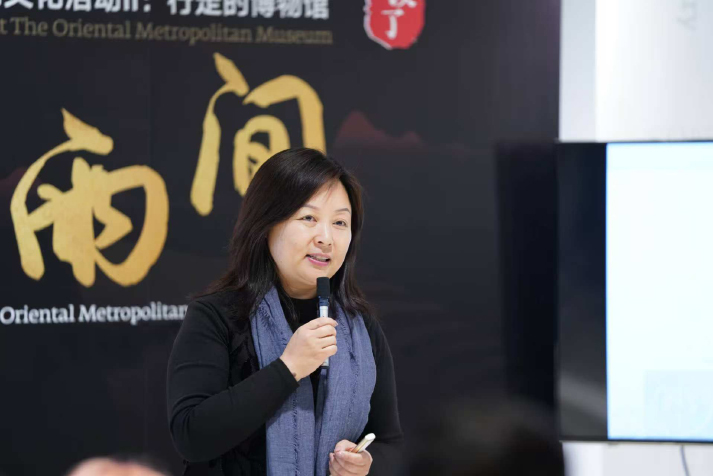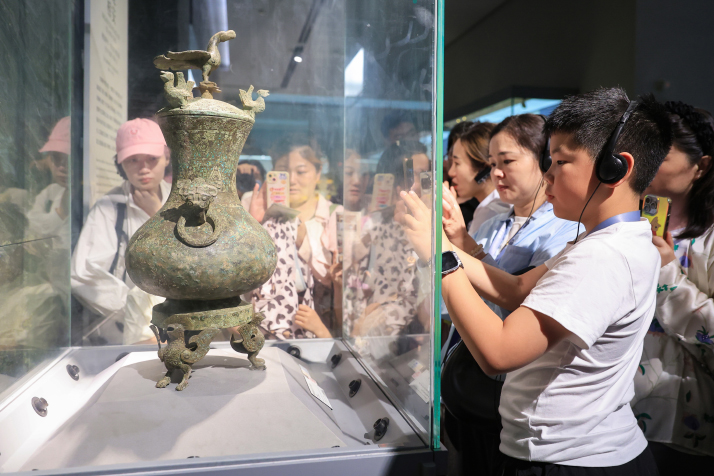| China |
| How one veteran curator is rewriting museum magic for Chinese youth | |
|
|
|
|
|
Song Yan, Deputy Director of the Nanjing Museum Administration has devoted more than three decades to connecting children and youth with the treasures of China's past. She is also a deputy to the 14th National People's Congress (NPC), China's top legislature, from Jiangsu Province's capital of Nanjing—the ancient capital of six dynasties. From her early days as a junior curator at Chaotian Palace in Nanjing in 1989, to her current role as both a veteran cultural steward and national lawmaker, Song has helped transform museums into an exciting part of public life.  Song Yan, Deputy Director of the Nanjing Museum Administration and a deputy to the 14th National People's Congress, China's top legislature (SUN YUANPENG)
Booming museums Song believes that the long-term vitality of museums depends on quality, especially in exhibit design and presentation. "Our exhibitions are now much more people-centered," she explained. "When preparing an exhibition, we ask: What does the audience want to see? Who are we speaking to?" Differentiated exhibitions are another driver of the museum boom. As a branch of the Nanjing Museum Administration, the Oriental Metropolitan Museum has carved out its own identity through specialized development and thematic exhibitions. It has evolved into a distinctive art space with a strong focus on youth education and volunteer service—factors that have helped it attract a steady stream of visitors and volunteers. The people-centered mindset has gone hand in hand with technological innovation. From early sound-and-light installation to immersive virtual reality (VR), museums have continued to evolve. At the Grand Baoen Temple Heritage and Scenic Area in Nanjing, visitors can use smartphones to interact with Ming Dynasty (1368-1644) figures through augmented reality (AR). "Whether it's through AR or VR, the goal is the same: to help people—especially youth—connect more deeply with traditional culture," Song said. According to surveys by the Nanjing Museum Administration, over 70 percent of museum-goers in Nanjing are young people. "Many of them arrive dressed in traditional Chinese attire, take in the exhibits and take home cultural souvenirs," she added. In 2024, sales of such souvenirs in China reached 3.43 billion yuan ($478.57 million)—a 63.7-percent year-on-year increase. Items featuring traditional Chinese elements were the bestsellers. "That's cultural confidence in action—expressed in these subtle, everyday ways," Song said.  Visitors at the Nanjing Museum on May 17. Museums across China organized lively activities to mark International Museum Day on May 18 (XINHUA)
Museums for all As an NPC deputy, Song brings the voice of museums straight to the national legislature. On March 5, 2024, when President Xi Jinping participated in a deliberation with his fellow lawmakers from Jiangsu at the Second Session of the 14th NPC, Song introduced Nanjing's museum development. Xi emphasized the need to develop museums in a more refined and systematic manner. Nanjing is home to many universities, including 67 university-affiliated museums "These museums excel in collections and research," Song said. "We believe they are essential to building a more comprehensive and systematic museum network." "We're working toward making Nanjing a 'city of museums'," she added. "By 2027, we aim to have 100 registered museums. We hope to incorporate university museums into the system, so that we can collaborate more effectively in providing public services, educational events, as well as tailored programs that meet the needs of young people." For Song, museums should be accessible to all. One of her major proposals to the NPC was the creation of child-friendly museums—a vision already being realized. At the Nanjing Folk Museum, for example, displays have been lowered, and lighting adjusted to better accommodate young visitors. "We don't have national standards yet," she said. "But we're exploring how to make these spaces more engaging and comfortable for children." Across Nanjing, children are now a central focus of museum education—from interactive exhibits and storytelling to heritage crafts and historical reenactments. In 2024 alone, Chinese museums curated 43,000 original exhibitions and hosted more than 510,600 offline educational events. The Nanjing Museum Administration contributed with more than 40 exhibitions and 1,200 public education activities. "I hope children can grow up in museums," Song said. "I believe they'll gain a deep understanding of our history—and that's perhaps the most meaningful result of all our efforts." President Xi hopes the public—especially young people—can have deeper engagement with museums and a better understanding of history. Thanks to advocates like Song, that future is already taking shape—one curious child at a time. Reaching out To better serve increasing number of visitors, Song has expanded the volunteer program and created a volunteer team known as "Liuchaoqing." Volunteers have been recruited from across the community, ranging in age from 22 to 60. "I wanted people who can grow alongside the museum," she explained. "Together, we would build up our museums and help introduce them to a wider public." "In the early days, our resources were limited," Song said. So volunteers were recruited to offer help. "When more than 100 people signed up to volunteer at the Oriental Metropolitan Museum, I was deeply moved. I hadn't expected such a strong commitment to museum volunteering." Today, Liuchaoqing has grown into a structured, stable volunteer team that includes working adults, university students, and even children. Over the past decade, the team has consistently maintained a strong core of more than 100 active members, contributing not just on weekends but throughout the week. In 2018, Song registered Liuchaoqing as a trademark—a move seldom seen in the museum world. "I wanted the name to carry more weight and to highlight the value of volunteer service in museums," she said. Beyond museum walls, Liuchaoqing volunteers and museum staff have partnered to bring educational outreach programs to neighborhoods, government offices, and schools. Long-term partnerships with local schools have supported not just lectures, but field trips, deepening community engagement with cultural heritage. In many ways, the development of museums mirrors the public's growing interest in culture, Song said. As China continues to modernize its cultural infrastructure, Song has watched museums evolve from quiet, dusty halls into dynamic centers of discovery and dialogue. Yet through it all, her mission remains the same: helping the next generation build a lifelong relationship with history. "But ultimately, it's the dedication of our staff and volunteers that has made the difference. Guided by a respect for history and a passion of preservation, we've carried this mission forward together," she said. "We want our museums to be part of everyday life," she said. "A place where people can relax, learn, be entertained—and grow." BR (Print Edition Title: The Past as a Playground) Copyedited by Elsbeth van Paridon Comments to linan@cicgamericas.com |
|
||||||||||||||||||||||||||||
|